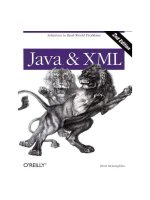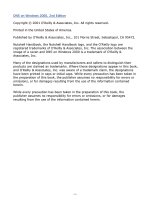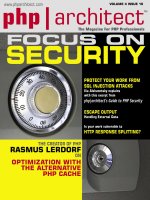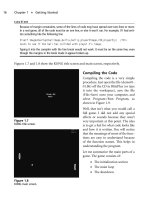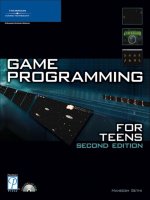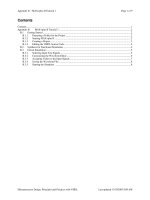Tài liệu Ruby on Rails Tutorial 2nd Edition pptx
Bạn đang xem bản rút gọn của tài liệu. Xem và tải ngay bản đầy đủ của tài liệu tại đây (10.61 MB, 589 trang )
ptg8286261
www.it-ebooks.info
ptg8286261
Praise for Michael Hartl’s
Books and Videos
on Ruby on Rails
TM
‘‘My former company (CD Baby) was one of the first to loudly switch to Ruby on
Rails, and then even more loudly switch back to PHP (Google me to read about the
drama). This book by Michael Hartl came so highly recommended that I had to try
it, and the Ruby on Rails
TM
Tutorial is what I used to switch back to Rails again.’’
—From the Foreword by Derek Sivers (sivers.org)
Formerly: Founder, CD Baby
Currently: Founder, Thoughts Ltd.
‘‘Michael Hartl’s Rails Tutorial book is the #1 (and only, in my opinion) place to
start when it comes to books about learning Rails. . . . It’s an amazing piece of work
and, unusually, walks you through building a Rails app from start to finish with
testing. If you want to read just one book and feel like a Rails master by the end of
it, pick the Ruby on Rails
TM
Tutorial.’’
—Peter Cooper
Editor, Ruby Inside
www.it-ebooks.info
ptg8286261
‘‘Grounded in the real world.’’
—I Programmer (www.i-programmer.info), by Ian Elliot
‘‘The book gives you the theory and practice, while the videos focus on showing you
in person how its done. Highly recommended combo.’’
—Antonio Cangiano, Software Engineer, IBM
‘‘The author is clearly an expert at the Ruby language and the Rails framework, but
more than that, he is a working software engineer who introduces best practices
throughout the text.’’
—Greg Charles, Senior Software Developer, Fairway Technologies
‘‘Overall, these video tutorials should be a great resource for anyone new to Rails.’’
—Michael Morin, ruby.about.com
‘‘Hands-down, I would recommend this book to anyone wanting to get into Ruby
on Rails development.’’
—Michael Crump, Microsoft MVP
www.it-ebooks.info
ptg8286261
RUBY ON RAILS
TM
T
UTORIAL
Second Edition
www.it-ebooks.info
ptg8286261
Visit
informit.com/ruby
for a
complete list
of
available products.
I
he
Addison-Wesley Professional Ruby Series provides readers
with practical, people-oriented,
and
in-depth information about
T
applying
the
Ruby platform
to
create dynamic technology solutions.
The
series
is
based
on the
premise that
the
need
for
expert reference
books, written
by
experienced practitioners, will never
be
satisfied solely
by
blogs
and the
Internet.
www.it-ebooks.info
ptg8286261
RUBY ON RAILS
TM
TUTORIAL
Learn Web Developments with Rails
Second Edition
Michael Hartl
Upper Saddle River, NJ
•
Boston
•
Indianapolis
•
San Francisco
New York
•
Toronto
•
Montreal
•
London
•
Munich
•
Paris
•
Madrid
Capetown
•
Sydney
•
Tokyo
•
Singapore
•
Mexico City
www.it-ebooks.info
ptg8286261
Many of the designations used by manufacturers and sellers to distinguish their products are claimed
as trademarks. Where those designations appear in this book, and the publisher was aware of a
trademark claim, the designations have been printed with initial capital letters or in all capitals.
The author and publisher have taken care in the preparation of this book, but make no expressed or
implied warranty of any kind and assume no responsibility for errors or omissions. No liability is
assumed for incidental or consequential damages in connection with or arising out of the use of the
information or programs contained herein.
The publisher offers excellent discounts on this book when ordered in quantity for bulk purchases or
special sales, which may include electronic versions and/or custom covers and content particular to
your business, training goals, marketing focus, and branding interests. For more information, please
contact:
U.S. Corporate and Government Sales
(800) 382-3419
For sales outside the United States please contact:
International Sales
Visit us on the Web: informit.com/aw
Cataloging-in-Publication Data is on file with the Library of Congress.
Copyright © 2013 Michael Hartl
All rights reserved. Printed in the United States of America. This publication is protected by
copyright, and permission must be obtained from the publisher prior to any prohibited reproduction,
storage in a retrieval system, or transmission in any form or by any means, electronic, mechanical,
photocopying, recording, or likewise. To obtain permission to use material from this work, please
submit a written request to Pearson Education, Inc., Permissions Department, One Lake Street,
Upper Saddle River, New Jersey 07458, or you may fax your request to (201) 236-3290.
The source code in Ruby on Rails
TM
Tutorial is released under the MIT License.
ISBN 13: 978-0-321-83205-4
ISBN 10: 0-321-83205-1
Text printed in the United States on recycled paper at Edwards Brothers Malloy in Ann Arbor,
Michigan.
First printing, July 2012
Editor-in-Chief
Mark Taub
Executive Editor
Debra Williams Cauley
Managing Editor
John Fuller
Full-Service Production
Manager
Julie B. Nahil
Project Manager
Laserwords
Copy Editor
Laserwords
Indexer
Laserwords
Proofreader
Laserwords
Reviewer
Jennifer Lindner
Publishing Coordinator
Kim Boedigheimer
Cover Designer
Chuti Prasertsith
Compositor
Laserwords
www.it-ebooks.info
ptg8286261
Contents
Foreword to the First Edition by Derek Sivers xv
Foreword to the First Edition by Obie Fernandez xvii
Acknowledgments xix
About the Author xxi
Chapter 1 From Zero to Deploy 1
1.1 Introduction 3
1.1.1 Comments for Various Readers 4
1.1.2 ‘‘Scaling’’ Rails 7
1.1.3 Conventions in This Book 7
1.2 Up and Running 9
1.2.1 Development Environments 10
1.2.2 Ruby, RubyGems, Rails, and Git 12
1.2.3 The First Application 17
1.2.4 Bundler 19
1.2.5 rails server 23
1.2.6 Model-view-controller (MVC) 25
1.3 Version Control with Git 27
1.3.1 Installation and Setup 27
1.3.2 Adding and Committing 30
1.3.3 What Good Does Git Do You? 31
vii
www.it-ebooks.info
ptg8286261
viii Contents
1.3.4 GitHub 32
1.3.5 Branch, Edit, Commit, Merge 34
1.4 Deploying 39
1.4.1 Heroku Setup 39
1.4.2 Heroku Deployment, Step One 40
1.4.3 Heroku Deployment, Step Two 40
1.4.4 Heroku Commands 41
1.5 Conclusion 43
Chapter 2 A Demo App 45
2.1 Planning the Application 45
2.1.1 Modeling Demo Users 47
2.1.2 Modeling Demo Microposts 48
2.2 The Users Resource 49
2.2.1 A User Tour 51
2.2.2 MVC in Action 56
2.2.3 Weaknesses of this Users Resource 62
2.3 The Microposts Resource 63
2.3.1 A Micropost Microtour 63
2.3.2 Putting the micro in Microposts 66
2.3.3 A User has
many Microposts 68
2.3.4 Inheritance Hierarchies 70
2.3.5 Deploying the Demo App 73
2.4 Conclusion 74
Chapter 3 Mostly Static Pages 77
3.1 Static Pages 82
3.1.1 Truly Static Pages 82
3.1.2 Static Pages with Rails 85
3.2 Our First Tests 93
3.2.1 Test-driven Development 93
3.2.2 Adding a Page 99
3.3 Slightly Dynamic Pages 103
3.3.1 Testing a Title Change 103
3.3.2 Passing Title Tests 106
3.3.3 Embedded Ruby 108
3.3.4 Eliminating Duplication with Layouts 111
3.4 Conclusion 114
www.it-ebooks.info
ptg8286261
Contents ix
3.5 Exercises 114
3.6 Advanced Setup 117
3.6.1 Eliminating bundle exec 118
3.6.2 Automated Tests with Guard 120
3.6.3 Speeding up Tests with Spork 123
3.6.4 Tests inside Sublime Text 127
Chapter 4 Rails-Flavored Ruby 129
4.1 Motivation 129
4.2 Strings and Methods 134
4.2.1 Comments 134
4.2.2 Strings 135
4.2.3 Objects and Message Passing 138
4.2.4 Method Definitions 141
4.2.5 Back to the Title Helper 142
4.3 Other Data Structures 142
4.3.1 Arrays and Ranges 142
4.3.2 Blocks 146
4.3.3 Hashes and Symbols 148
4.3.4 CSS revisited 152
4.4 Ruby Classes 153
4.4.1 Constructors 153
4.4.2 Class Inheritance 155
4.4.3 Modifying Built-in Classes 158
4.4.4 A Controller Class 159
4.4.5 A User Class 161
4.5 Conclusion 164
4.6 Exercises 164
Chapter 5 Filling in the Layout 167
5.1 Adding Some Structure 167
5.1.1 Site Navigation 169
5.1.2 Bootstrap and Custom CSS 175
5.1.3 Partials 181
5.2 Sass and the Asset Pipeline 187
5.2.1 The Asset Pipeline 187
5.2.2 Syntactically Awesome Stylesheets 190
www.it-ebooks.info
ptg8286261
x Contents
5.3 Layout Links 197
5.3.1 Route Tests 200
5.3.2 Rails Routes 202
5.3.3 Named Routes 205
5.3.4 Pretty RSpec 207
5.4 User Signup: A First Step 211
5.4.1 Users Controller 212
5.4.2 Signup URI 213
5.5 Conclusion 215
5.6 Exercises 217
Chapter 6 Modeling Users 221
6.1 User Model 222
6.1.1 Database Migrations 223
6.1.2 The Model File 228
6.1.3 Creating User Objects 230
6.1.4 Finding User Objects 233
6.1.5 Updating User Objects 235
6.2 User Validations 236
6.2.1 Initial User Tests 236
6.2.2 Validating Presence 239
6.2.3 Length Validation 243
6.2.4 Format Validation 245
6.2.5 Uniqueness Validation 249
6.3 Adding a Secure Password 254
6.3.1 An Encrypted Password 255
6.3.2 Password and Confirmation 257
6.3.3 User Authentication 260
6.3.4 User Has Secure Password 263
6.3.5 Creating a User 265
6.4 Conclusion 267
6.5 Exercises 268
Chapter 7 Sign Up 271
7.1 Showing Users 271
7.1.1 Debug and Rails Environments 272
7.1.2 A Users Resource 278
www.it-ebooks.info
ptg8286261
Contents xi
7.1.3 Testing the User Show Page (with Factories) 282
7.1.4 A Gravatar Image and a Sidebar 286
7.2 Signup Form 292
7.2.1 Tests for User Signup 293
7.2.2 Using form
for 297
7.2.3 The Form HTML 301
7.3 Signup Failure 303
7.3.1 A Working Form 303
7.3.2 Signup Error Messages 308
7.4 Signup Success 312
7.4.1 The Finished Signup Form 313
7.4.2 The Flash 315
7.4.3 The First Signup 317
7.4.4 Deploying to Production with SSL 317
7.5 Conclusion 321
7.6 Exercises 321
Chapter 8 Sign In, Sign Out 325
8.1 Sessions and Signin Failure 325
8.1.1 Sessions Controller 326
8.1.2 Signin Tests 330
8.1.3 Signin Form 333
8.1.4 Reviewing Form Submission 336
8.1.5 Rendering with a Flash Message 339
8.2 Signin Success 343
8.2.1 Remember Me 343
8.2.2 A Working sign
in Method 349
8.2.3 Current User 351
8.2.4 Changing the Layout Links 355
8.2.5 Signin upon Signup 359
8.2.6 Signing Out 361
8.3 Introduction to Cucumber (Optional) 363
8.3.1 Installation and Setup 364
8.3.2 Features and Steps 365
8.3.3 Counterpoint: RSpec Custom Matchers 368
8.4 Conclusion 371
8.5 Exercises 372
www.it-ebooks.info
ptg8286261
xii Contents
Chapter 9 Updating, Showing, and Deleting Users 373
9.1 Updating Users 373
9.1.1 Edit Form 374
9.1.2 Unsuccessful Edits 380
9.1.3 Successful Edits 382
9.2 Authorization 385
9.2.1 Requiring Signed-in Users 386
9.2.2 Requiring the Right User 390
9.2.3 Friendly Forwarding 392
9.3 Showing All Users 396
9.3.1 User Index 396
9.3.2 Sample Users 403
9.3.3 Pagination 404
9.3.4 Partial Refactoring 410
9.4 Deleting Users 413
9.4.1 Administrative Users 413
9.4.2 The destroy Action 417
9.5 Conclusion 422
9.6 Exercises 424
Chapter 10 User Microposts 429
10.1 A Micropost Model 429
10.1.1 The Basic Model 430
10.1.2 Accessible Attributes and the First Validation 432
10.1.3 User/Micropost Associations 433
10.1.4 Micropost Refinements 439
10.1.5 Content Validations 443
10.2 Showing Microposts 445
10.2.1 Augmenting the User Show Page 446
10.2.2 Sample Microposts 450
10.3 Manipulating Microposts 454
10.3.1 Access Control 456
10.3.2 Creating Microposts 459
10.3.3 A Proto-feed 467
10.3.4 Destroying Microposts 475
10.4 Conclusion 479
10.5 Exercises 480
www.it-ebooks.info
ptg8286261
Contents xiii
Chapter 11 Following Users 483
11.1 The Relationship Model 484
11.1.1 A Problem with the Data Model (and a Solution) 485
11.1.2 User/Relationship Associations 491
11.1.3 Validations 495
11.1.4 Followed users 495
11.1.5 Followers 500
11.2 A Web Interface for Following Users 503
11.2.1 Sample Following Data 503
11.2.2 Stats and a Follow Form 505
11.2.3 Following and Followers Pages 515
11.2.4 A Working Follow Button the Standard Way 519
11.2.5 A Working Follow Button with Ajax 524
11.3 The Status Feed 529
11.3.1 Motivation and Strategy 530
11.3.2 A First Feed Implementation 532
11.3.3 Subselects 535
11.3.4 The New Status Feed 538
11.4 Conclusion 539
11.4.1 Extensions to the Sample Application 540
11.4.2 Guide to Further Resources 542
11.5 Exercises 543
Index 545
www.it-ebooks.info
ptg8286261
This page intentionally left blank
www.it-ebooks.info
ptg8286261
Foreword to the First Edition
My former company (CD Baby) was one of the first to loudly switch to Ruby on Rails,
and then even more loudly switch back to PHP (Google me to read about the drama).
This book by Michael Hartl came so highly recommended that I had to try it, and
Ruby on Rails
TM
3 Tutorial is what I used to switch back to Rails again.
Though I’ve worked my way through many Rails books, this is the one that finally
made me get it. Everything is done very much ‘‘the Rails way’’—a way that felt very
unnatural to me before, but now after doing this book finally feels natural. This is also
the only Rails book that does test-driven development the entire time, an approach
highly recommended by the experts but which has never been so clearly demonstrated
before. Finally, by including Git, GitHub, and Heroku in the demo examples, the
author really gives you a feel for what it’s like to do a real-world project. The tutorial’s
code examples are not in isolation.
The linear narrative is such a great format. Personally, I powered through the Rails
Tutorial in three long days, doing all the examples and challenges at the end of each
chapter. Do it from start to finish, without jumping around, and you’ll get the ultimate
benefit.
Enjoy!
—Derek Sivers (sivers.org)
Formerly: Founder, CD Baby
Currently: Founder, Thoughts Ltd.
xv
www.it-ebooks.info
ptg8286261
This page intentionally left blank
www.it-ebooks.info
ptg8286261
Foreword to the First Edition
‘‘If you want to learn web development with Ruby on Rails, how should I start?’’ For
years Michael Hartl has provided the answer as author of the RailsSpace tutorial in our
series and now the new Ruby on Rails
TM
3 Tutorial that you hold in your hands (or PDF
reader, I guess).
I’m so proud of having Michael on the series roster. He is living, breathing proof
that us Rails folks are some of the luckiest in the wide world of technology. Before
getting into Ruby, Michael taught theoretical and computational physics at Caltech for
six years, where he received the Lifetime Achievement Award for Excellence in Teaching
in 2000. He is a Harvard graduate, has a Ph.D. in Physics from Caltech, and is an
alumnus of Paul Graham’s esteemed Y Combinator program for entrepreneurs. And
what does Michael apply his impressive experience and teaching prowess to? Teaching
new software developers all around the world how to use Ruby on Rails effectively!
Lucky we are indeed!
The availability of this tutorial actually comes at a critical time for Rails adoption.
We’re five years into the history of Rails and today’s version of the platform has
unprecedented power and flexibility. Experienced Rails folks can leverage that power
effectively, but we’re hearing growing cries of frustration from newcomers. The amount
of information out there about Rails is fantastic if you know what you’re doing
already. However, if you’re new, the scope and mass of information about Rails can be
mind-boggling.
Luckily, Michael takes the same approach as his first book in the series, building
a sample application from scratch, and writes in a style that’s meant to be read from
start to finish. Along the way, he explains all the little details that are likely to trip up
xvii
www.it-ebooks.info
ptg8286261
xviii Foreword to the First Edition
beginners. Impressively, he goes beyond just a straightforward explanation of what Rails
does and ventures into prescriptive advice about good software development practices,
such as test-driven development. Neither does Michael constrain himself to a box
delineated by the extents of the Rails framework—he goes ahead and teaches the reader
to use tools essential to existence in the Rails community, such as Git and GitHub.
In a friendly style, he even provides copious contextual footnotes of benefit to new
programmers, such as the pronunciation of SQL and pointers to the origins of lorem
ipsum. Tying all the content together in a way that remains concise and usable is truly a
tour de force of dedication!
I tell you with all my heart that this book is one of the most significant titles in
my Professional Ruby Series, because it facilitates the continued growth of the Rails
ecosystem. By helping newcomers become productive members of the community
quickly, he ensures that Ruby on Rails continues its powerful and disruptive charge into
the mainstream. The Rails Tutorial is potent fuel for the fire that is powering growth
and riches for so many of us, and for that we are forever grateful.
—Obie Fernandez, Series Editor
www.it-ebooks.info
ptg8286261
Acknowledgments
The Ruby on Rails
TM
Tutorial owes a lot to my previous Rails book, RailsSpace, and
hence to my coauthor Aurelius Prochazka. I’d like to thank Aure both for the work he
did on that book and for his support of this one. I’d also like to thank Debra Williams
Cauley, my editor on both RailsSpace and the Ruby on Rails
TM
Tutorial; as long as she
keeps taking me to baseball games, I’ll keep writing books for her.
I’d like to acknowledge a long list of Rubyists who have taught and inspired me
over the years: David Heinemeier Hansson, Yehuda Katz, Carl Lerche, Jeremy Kemper,
Xavier Noria, Ryan Bates, Geoffrey Grosenbach, Peter Cooper, Matt Aimonetti, Gregg
Pollack, Wayne E. Seguin, Amy Hoy, Dave Chelimsky, Pat Maddox, Tom Preston-
Werner, Chris Wanstrath, Chad Fowler, Josh Susser, Obie Fernandez, Ian McFarland,
Steven Bristol, Wolfram Arnold, Alex Chaffee, Giles Bowkett, Evan Dorn, Long
Nguyen, James Lindenbaum, Adam Wiggins, Tikhon Bernstam, Ron Evans, Wyatt
Greene, Miles Forrest, the good people at Pivotal Labs, the Heroku gang, the thoughtbot
guys, and the GitHub crew. Thanks to Jen Lindner, Patty Donovan (Laserwords), and
Julie Nahil and Michael Thurston from Pearson for their help with the book. Finally,
many, many readers—far too many to list—have contributed a huge number of bug
reports and suggestions during the writing of this book, and I gratefully acknowledge
their help in making it as good as it can be.
xix
www.it-ebooks.info
ptg8286261
This page intentionally left blank
www.it-ebooks.info
ptg8286261
About the Author
Michael Hartl is the author of the Ruby on Rails
TM
Tutorial, the leading introduction
to web development with Ruby on Rails. His prior experience includes writing and
developing RailsSpace, an extremely obsolete Rails tutorial book, and developing Insoshi,
a once-popular and now-obsolete social networking platform in Ruby on Rails. In 2011,
Michael received a Ruby Hero Award for his contributions to the Ruby community.
He is a graduate of Harvard College, has a Ph.D. in physics from Caltech, and is an
alumnus of the Y Combinator entrepreneur program.
xxi
www.it-ebooks.info
ptg8286261
This page intentionally left blank
www.it-ebooks.info
ptg8286261
C
HAPTER
1
From Zero to Deploy
Welcome to Ruby on Rails
™
Tutorial. The goal of this book is to be the best answer to the
question, ‘‘If I want to learn web development with Ruby on Rails, where should I start?’’
By the time you finish the Rails Tutorial, you will have all the skills you need to develop
and deployyour own custom webapplications withRails. You will also be readyto benefit
from the many more advanced books, blogs, and screencasts that are part of the thriving
Rails educational ecosystem. Finally, since the Rails Tutorial uses Rails 3, the knowledge
you gain here represents the state of the art in web development. (The most up-to-date
version of the Rails Tutorial can be found on the book’s website at ;
if you are reading this book offline, be sure to check the online version of the Rails
Tutorial book at for the latest updates.)
Note that the goal of this book is not merely to teach Rails, but rather to teach
web development with Rails, which means acquiring (or expanding) the skills needed to
develop software for the World Wide Web. In addition to Ruby on Rails, this skillset
includes HTML and CSS, databases, version control, testing, and deployment. To
accomplish this goal, Rails Tutorial takes an integrated approach: You will learn Rails
by example by building a substantial sample application from scratch. As Derek Sivers
notes in the foreword, this book is structured as a linear narrative, designed to be read
from start to finish. If you are used to skipping around in technical books, taking this
linear approach might require some adjustment, but I suggest giving it a try. You can
think of the Rails Tutorial as a video game where you are the main character and where
you level up as a Rails developer in each chapter. (The exercises are the minibosses.)
1
www.it-ebooks.info
ptg8286261
2 Chapter 1: From Zero to Deploy
In this first chapter, we’ll get started with Ruby on Rails by installing all the necessary
software and by setting up our development environment (Section 1.2). We’ll then
create our first Rails application, called (appropriately enough)
first_app
. The Rails
Tutorial emphasizes good software development practices, so immediately after creating
our fresh new Rails project we’ll put it under version control with Git (Section 1.3).
And, believe it or not, in this chapter we’ll even put our first app on the wider web by
deploying it to production (Section 1.4).
In Chapter 2, we’ll make a second project, whose purpose is to demonstrate the
basic workings of a Rails application. To get up and running quickly, we’ll build this
demo app (called
demo_app
) using scaffolding (Box 1.1) to generate code; since this
code is both ugly and complex, Chapter 2 will focus on interacting with the demo app
through its URIs (sometimes called URLs)
1
using a web browser.
The rest of the tutorial focuses on developing a single large sample application (called
sample_app
), writing all the code from scratch. We’ll develop the sample app using
test-driven development (TDD), getting started in Chapter 3 by creating static pages
and then adding a little dynamic content. We’ll take a quick detour in Chapter 4 to
learn a little about the Ruby language underlying Rails. Then, in Chapter 5 through
Chapter 9, we’ll complete the foundation for the sample application by making a site
layout, a user data model, and a full registration and authentication system. Finally,
in Chapter 10 and Chapter 11 we’ll add microblogging and social features to make a
working example site.
The final sample application will bear more than a passing resemblance to a certain
popular social microblogging site—a site that, coincidentally, was also originally written
in Rails. Although of necessity our efforts will focus on this specific sample application,
the emphasis throughout the Rails Tutorial will be on general principles, so that you will
have a solid foundation no matter what kinds of web applications you want to build.
Box 1.1 Scaffolding: Quicker, Easier, More Seductive
From the beginning, Rails has benefited from a palpable sense of excitement,
starting with the famous 15-minute weblog video by Rails creator David Heinemeier
Hansson. That video and its successors are a great way to get a taste of Rails’ power,
1. URI stands for Uniform Resource Identifier, while the slightly less general URL stands for Uniform Resource
Locator. In practice, the URI is usually equivalent to ‘‘the thing you see in the address bar of your browser.’’
www.it-ebooks.info
